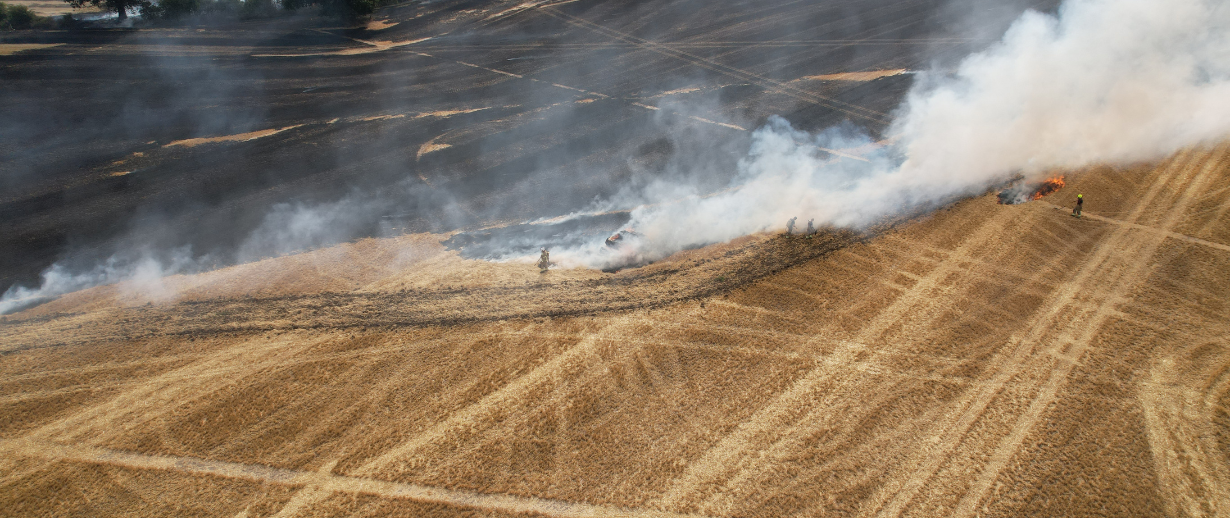Temperatures

When we think back to weather extremes in 2022, one of the first things that comes to mind is the scorching summer. With large parts of the south of England recording temperatures exceeding 40°C, the heat caused forest fires as well as roads and airport runways to melt. In the days preceding these events, the Met Office was forced to issue its first-ever red warning for extreme heat.
Dr McCarthy, head of the Met Office’s National Climate Information Centre believes that human activity is to blame. “The temperatures witnessed in mid-July would have been extremely unlikely in the pre-industrial period – the era before humanity started emitting lots of greenhouse gases by burning fossil fuels.”
However, it wasn’t just the summer that was hotter than usual. With December as an exception, temperatures were above average every month in 2022. Overall, this meant that the yearly average temperature in the UK was 10.03°C, exceeding the previous record of 9.88°C, which was set in 2014.
What’s more, globally, 2022 was the sixth warmest year since records began in 1880 and was 0.86°C above the 20th-century average of 13.9°C. It was also the ninth year in succession that the global average temperature has reached at least 1°C above pre-industrial levels.
Rainfall and storms

The UK also experienced a huge shortage in rainfall last year. The summer was the tenth driest on record, with some areas in eastern and southern England recording virtually no rain in July. This meant that by August, no year had been as dry up until that point since 1976.
With less rainfall and high temperatures causing existing water sources to diminish through evaporation, water availability reduced significantly. As such, water companies such as Thames Water and Yorkshire Water tried to protect resources by issuing a hosepipe ban.
The outlook for 2023

The trend for extreme weather and water shortages looks to continue, impacted by the lack of a particular oceanic and atmospheric phenomenon: La Niña. This is where cooler-than-average sea water rises to the surface of the tropical Pacific Ocean. This in turn absorbs some of the heat from the air - creating a natural and periodic ocean cooling effect. La Niña lasts 1-3 years and thankfully, in recent times, has helped to reduce the effects of climate change.
However, the current phase of La Niña is due to subside, bringing an end to this cooling effect and the return of El Niño – an opposing warm phase which lasts 9-12 months. Known to affect the global climate and disrupt normal weather patterns, El Niño years usually coincide with annual global temperature increases. Consequently, the Met Office is predicting 2023 could be one of the hottest years in history.
Solutions

As global warming increases, water scarcity is going to become more of a problem so it’s crucial for companies that rely heavily on water for their operations, to find ways to reduce consumption. Thankfully there are a variety of ways to achieve this:
-
Recycling water. In many applications, wastewater can be recycled back to a plant inlet and treated again. The water rejected by reverse osmosis (RO) for example has a high level of total dissolved solids (TDS) and is sent to a reject stream where it is discharged. However, this reject stream could be fed through a secondary RO unit to treat again.
-
Reusing water. Wastewater is usually discarded, however in certain cases, it can be reused for other applications. For example, industrial wastewater that results from process or washing water can be used as boiler feed or cooling processes.
-
Modern technology. Water consumption can be reduced by replacing old systems with modern, water-efficient technology. A traditional RO unit for instance could be replaced by a higher efficiency product such as TERION™ which combines RO with continuous electrodeionisation (CEDI) within a single unit.
You can find out more about reusing and recycling water by reading our blog on the topic, here
Even after a year of extreme weather, the effects of climate change could make 2023 even more extreme. VWT UK’s experience, expertise and commitment makes it the ideal partner to help businesses lower their environmental impact and water consumption.
To learn more about VWT UK’s climate change efforts, please visit, here.